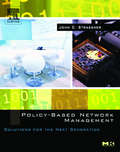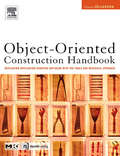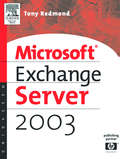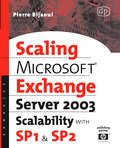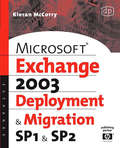- Table View
- List View
Server Architectures: Multiprocessors, Clusters, Parallel Systems, Web Servers, Storage Solutions
by René J. ChevanceThe goal of this book is to present and compare various options one for systems architecture from two separate points of view. One, that of the information technology decision-maker who must choose a solution matching company business requirements, and secondly that of the systems architect who finds himself between the rock of changes in hardware and software technologies and the hard place of changing business needs. Different aspects of server architecture are presented, from databases designed for parallel architectures to high-availability systems, and touching en route on often- neglected performance aspects.The book provides IT managers, decision makers and project leaders who want to acquire knowledge sufficient to understand the choices made in and capabilities of systems offered by various vendorsProvides system design information to balance the characteristic applications against the capabilities and nature of various architectural choicesIn addition, it offers an integrated view of the concepts in server architecture, accompanied by discussion of effects on the evolution of the data processing industry
Resilient Storage Networks: Designing Flexible Scalable Data Infrastructures
by Greg SchulzA resilient storage network is an environment where data is always available for the needs of the business. This book explains the components, as well as how to design and implement a resilient storage network for workgroup, departmental, and enterprise environments. Storage networks are an enabling capability combining technology and best practices to provide the foundation to support information technology systems and applications. Storage networks can be of various sizes, shapes, and technologies. This book shows you how to implement a resilient storage network infrastructure using different technologies including ATM, DWDM, FCIP, Fibre Channel, FICON, iFCP, InfiniBand, IP, iSCSI, Life Cycle Management, NAS, Object Based Storage, RAID, RDMA, Remote Mirroring, Replication, SAN, SCSI, SMI-S, SONET/SDH, Storage Services, Tape, Virtualization, and Volume Managers.*Important information is clarified and put into context to separate myths and realities *Covers storage networking technologies (hardware, software, networks) and practices*Numerous tips and recommendations allow the reader to quickly understand best practices*Checklists, templates and examples show potential solutions
RAPID Value Management for the Business Cost of Ownership: Readiness, Architecture, Process, Integration, Deployment (HP Technologies)
by Andrew WigodskyThe model presented in this manual for the IT professional helps managers work with tech workers and their customers to make a clear and well-substantiated argument for IT service investments. In order to validate and fully explain this model, Wigodsky presents an overview of the "why" behind technology investment for any organization, and combines this with detailed real-world solutions that maximize BCO efficiency. By eliminating the "futz factor" commonly associated with system ownership costs, the book provides a glimpse of the next generation IT architecture, a repeatable process for identifying organization-wide system costs, and a customizable model for integrating BCO management with your people, processes, and technology.· Provides detailed technical architectures, processes, and integrated solutions using common computing technologies· Helps the reader build a customized model for reviewing the long-term potential costs and benefits of interrelated IT investments· Includes observations of HP thought leaders, experienced consultants, and customers on past projects
Policy-Based Network Management: Solutions for the Next Generation (ISSN)
by John StrassnerPolicy-Based Network Management (PBNM) systems enable business rules and procedures to be translated into policies that configure and control the network and its services. Those who manage network systems are aware that this approach can benefit both network management as well as the development of applications that use network services; however, the details surrounding these systems has been obscured by marketing hype, numerous acronyms, and theoretical complexities. Policy-Based Network Management: Solutions for the Next Generation cuts through the hype surrounding PBNM and makes it approachable for those who really need to understand what it has to offer. The author, founder of the IETF Policy Framework working group, discusses system requirements, information models, and system components for Policy-Based Management. He also provide practitioners with a resource for developing and/or incorporating PBNM systems. As network systems become larger and more complex, creating policies for them has become a crucial step in the management of network systems, and this book is a welcome addition to this exciting approach.* Presents a completely new approach to PBNM that unites the business, system, and implementation spheres.* As the basis for examples and discussion, uses the DEN-ng information model, an easy-to-understand open standard tied closely to eTOM and NGOSS.* Introduces the Ponder system, then examines Ponder extensions designed to enhance the structure of high-level policies and their application in a PBNM system.* Filled with examples illustrating how policies are most effectively used in a PBNM system and what new directions PBNM is likely to take.
Oracle Real Application Clusters
by Murali VallathClustered configuration first hit the scene nearly 20 years ago when Digital Equipment Corporation (DEC) introduced the VaxCluster. Until now, the topic of Real Application Clusters (RAC) implementation had never been fully explored. For the first time, Murali Vallath dissects RAC mysteries in his book Oracle Real Application Clusters to enlighten and educate readers on the internals of RAC operations, cache fusion, fusion recovery processes and the fast reconfiguration of RAC.This book provides comprehensive coverage of the features, technology and principles of RAC that is part of the Oracle9i release of Oracle's RDBMS product. It is divided into three main parts: application/database design, development and maintenance life cycles. Compared to its predecessor OPS, the architecture behind RAC implementation have changed significantly. Vallath discusses Oracle9i features in a RAC implementation with respect to usage and design considerations, as well as those parameters that are and are not applicable. Areas covered include partitioning, indexes, tablespace management, transaction management, backup and recovery principles. Performance tuning with examples, troubleshooting and problem solving scenarios are covered in detail, as well as discussions on the migration process from a single instance database to RAC and migration from an OPS implementation to RAC.Oracle Real Application Clusters takes readers through a logical flow from RAC concepts to operations, covering each facet with a fine-tooth comb. Vallath's skilled writing style makes each chapter entertaining and informative as only a true RAC connoisseur can provide. New and experienced users of RAC, as well as those seeking to expand their knowledge of this dynamic technology, will find this book to be a necessity for both home and office reference libraries.*Focuses on implementing, testing and tuning features of Real Application Clusters (RAC)*Provides extensive coverage of usage, day-to-day functions and operations*Includes tips and techniques such as script samples to illustrate various features of RAC*Unravels the internals of RAC architecture
Oracle 10g RAC Grid, Services and Clustering
by Murali VallathGrid architecture is Oracle’s strategy for high-end computing and RAC is the stepping stone into this arena. This book focuses on current technology including all valid RAC features up through Oracle Database 10g Release 2, with a primary focus on deploying it in a high-end grid environment. The book discusses this technology at length which users will find beneficial when researching, implementing or monitoring a RAC environment. The author covers workshop implementation of services and the distribution of workload across instances, with threshold definitions and the new load balancing algorithms. In addition it includes detailed discussions on ASM that complements the implementation of RAC in Oracle Grid strategy. The book also includes discussions on new Oracle Clusterware, its components and its integration with RAC. Oracle 10g RAC focuses on RAC-specific topics including ASM, operating system configuration, installation and configuration of RAC and much more. Coverage includes network configuration for high availability, FAN, TAF, ONS, implementation of maximum availability architecture (MAA), EM Grid Control, AWR, ADDM and other performance-related tools. The author includes several scripts for performance tuning and implementation that the reader can use to configure a RAC environment either on a 2, 4, 8, 60 or 99 node configuration.Focuses on implementing, testing and tuning features of Real Application Clusters (RAC) database version 10g Release 2Provides extensive coverage of usage, day-to-day functions and operationsIncludes tips and techniques such as script samples to illustrate various features of RACA jumpstart into all the key features of 10g R2 RAC
Oracle Performance Tuning for 10gR2
by Gavin JT PowellTuning of SQL code is generally cheaper than changing the data model. Physical and configuration tuning involves a search for bottlenecks that often points to SQL code or data model issues. Building an appropriate data model and writing properly performing SQL code can give 100%+ performance improvement. Physical and configuration tuning often gives at most a 25% performance increase. Gavin Powell shows that the central theme of Oracle10gR2 Performance Tuning is four-fold: denormalize data models to fit applications; tune SQL code according to both the data model and the application in relation to scalability; create a well-proportioned physical architecture at the time of initial Oracle installation; and most important, mix skill sets to obtain the best results.Fully updated for version 10gR2 and provides all necessary transition material from version 9iIncludes all three aspects of Oracle database tuning: data model tuning, SQL & PL/SQL code tuning, physical plus configuration tuningContains experienced guidance and real-world examples using large datasets Emphasizes development as opposed to operating system perspective
Oracle 10g Developing Media Rich Applications
by Lynne Dunckley Larry GurosOracle 10g Developing Media Rich Applications is focused squarely on database administrators and programmers as the foundation of multimedia database applications. With the release of Oracle8 Database in 1997, Oracle became the first commercial database with integrated multimedia technology for application developers. Since that time, Oracle has enhanced and extended these features to include native support for image, audio, video and streaming media storage; indexing, retrieval and processing in the Oracle Database, Application Server; and development tools. Databases are not only words and numbers for accountants, but they also should utilize a full range of media to satisfy customer needs, from race car engineers, to manufacturing processes to security. The full range of audio, video and integration of media into databases is mission critical to these applications. This book details the most recent features in Oracle’s multimedia technology including those of the Oracle10gR2 Database and the Oracle9i Application Server. The technology covered includes: object relational media storage and services within the database, middle tier application development interfaces, wireless delivery mechanisms, and Java-based tools.* Gives broad coverage to integration of multimedia features such as audio and instrumentation video, from race cars to analyze performance, to voice and picture recognition for security data bases. As well as full multimedia for presentations* Includes field tested examples in enterprise environments* Provides coverage in a thorough and clear fashion developed in a London University Professional Course
Open Source Software: Implementation and Management
by Paul KavanaghIn 2004/5, over half of IT professionals will be looking at open source, most for the first time. This book provides key tools for System administrators, Network Administrators, IT project managers, and consultants who must evaluate and deploy open source software. This book details open source successes so far, explains which scenarios are the most realistic opportunities now, then gives the details needed to select these solutions, adopt the best tools and practices, introduce them to an organization, implement and manage them. The IT professional can use this book to review opportunities in their organization, evaluate components such as Apache, Linux, and OpenOffice against systems they know, and follow up in detail on their specific interests here and through referred resources.*Deployment scenarios categorized by function and industry*Rules of thumb on where and when open source software is or is not the right choice*Roadmaps for deployment in terms of the components of open source
Object-Oriented Construction Handbook: Developing Application-Oriented Software with the Tools & Materials Approach
by Heinz ZüllighovenSuccessful businesses and organizations are continually looking for ways to improve service and customer satisfaction in order to achieve long-term customer loyalty. In light of these goals, software developers must ask the question: how does customer orientation influence traditional approaches, methods, and principles of software development? In this book, a leading software architect and his team of software engineers describe how the idea of customer orientation in an organization leads to the creation of application-oriented software. This book describes what application-oriented software development is and how it can be conceptually and constructively designed with object-oriented techniques. It goes further to describe how to best fit together the many different methodologies and techniques that have been created for object-orientation (such as frameworks, platforms, components, UML, Unified Process, design patterns, and eXtreme Programming) to design and build software for real projects. This book brings together the best of research, development, and day-to-day project work to the task of building large software systems.*Written by and for developers of large, interactive, and long-lived software systems*Includes patterns of proven analysis, design, and documentation techniques*Shows how to develop an appropriate design approach and concrete software development techniques
Network Programming in .NET: With C# and Visual Basic .NET
by Fiach ReidThe purpose of this book is to provide tools to design and implement network-orientated applications in .NET. It is also a guide for software designers to choose the best and most efficient way to implement mission critical solutions. The book addresses real-world issues facing professional developers, such as using third-party components as opposed in-house development. It differentiates itself from existing .NET publications because it is aimed at experienced professionals and concentrates on practical, ready-to-use information. The book is written in two languages C# and VB.NET, and covers never-before published information on Telephony in .NET and packet-level networking. This is the second book in the Digital Press Software Development Series.Coverage of lower level protocols allows implementation of performance-centric applicationsDemonstrates the feasibility of developing telephony solutions in-house rather than outsourcingWritten in VB.NET and C# to assist readers working in either languageCoverage of Email, FTP and the WWW allows implementation of applications in all three areas
Network Processor Design: Issues and Practices (ISSN #Volume 2)
by Mark A. Franklin Patrick Crowley Haldun Hadimioglu Peter Z. OnufrykResponding to ever-escalating requirements for performance, flexibility, and economy, the networking industry has opted to build products around network processors. To help meet the formidable challenges of this emerging field, the editors of this volume created the first Workshop on Network Processors, a forum for scientists and engineers to discuss latest research in the architecture, design, programming, and use of these devices. This series of volumes contains not only the results of the annual workshops but also specially commissioned material that highlights industry's latest network processors. Like its predecessor volume, Network Processor Design: Principles and Practices, Volume 2 defines and advances the field of network processor design. Volume 2 contains 20 chapters written by the field's leading academic and industrial researchers, with topics ranging from architectures to programming models, from security to quality of service.Describes current research at UNC Chapel Hill, University of Massachusetts, George Mason University, UC Berkeley, UCLA, Washington University in St. Louis, Linköpings Universitet, IBM, Kayamba Inc., Network Associates, and University of Washington.Reports the latest applications of the technology at Intel, IBM, Agere, Motorola, AMCC, IDT, Teja, and Network Processing Forum.
NetWare Administration: NetWare 4.0-6.0
by Mark FoustNetWare Administration contains information from a consultant's or administrator's viewpoint. There are no other NetWare books like it. The author went right to the meat—the NetWare client starts Chapter 1. This book provides tips, tricks, high-level explanations and Foust's hardcore experience in the field for Novell. He includes information that his clients had to pay $10,000 a week to receive, including practical coverage of NDS, upgrading to 6.0, and thousands of detailed instructions to accomplish virtually any enterprise-wide task. This book has more specific information than any you have ever seen on NetWare. It covers NetWare 4.x through 5.x up to NetWare 6 (due out end of this year).Covers new features in v. 6.0Great for troubleshooting client problemsLearn how to re-design your NDS tree
Monitoring and Managing Microsoft Exchange Server 2003 (HP Technologies)
by Mike DaughertyThis authoritative book teaches IT professionals responsible for Exchange messaging systems how to efficiently manage the program's many and complex system capabilities and features. Once you've designed and implemented a messaging system, the bulk of the day-to-day work involves monitoring to ensure an optimum traffic flow, accomplished by continuously reviewing and fine-tuning dozens of system specifications and components. Monitoring and Managing Microsoft Exchange 2003 teaches readers proven and innovative techniques, tools, and procedures for managing and optimizing systems of all sizes and types built on Exchange 2003. Based on the author's own twenty years of messaging system experience and the collective experience of HP, the leading implementer of Exchange Server systems, this book will be a leading resource for Exchange administrators and designers.*Provides best practices and innovative everyday techniques for managing the enterprise Exchange environment*Teaches readers proven procedures for managing and optimizing systems of all sizes and types*Based on the author's own twenty years of messaging system experience
Mission-Critical Microsoft Exchange 2003: Designing and Building Reliable Exchange Servers (HP Technologies)
by Jerry CochranMission-Critical Microsoft Exchange 2003 provides a complete update of Cochran's Mission-Critical Microsoft Exchange 2000, and complements Tony Redmond's new book, the best-selling Microsoft Exchange Server 2003. This book includes many of the same high-availability topics as the first edition but also expands the coverage of storage technology, server technology, management, and security. The book meets the needs of an Exchange administrator or system implementer who is striving to maintain a production Exchange environment that delivers superior service levels, high availability, manageability and scalability with the lowest cost of ownership.· Gives "lessons learned" and other best practices from organizations that have successfully deployed Exchange· Includes material on the forthcoming release of Exchange 2003· Offers advice from one of the most experienced storage practitioners
Microsoft Windows Security Fundamentals: For Windows 2003 SP1 and R2
by Jan De Clercq Guido GrillenmeierThis is the first of two books serving as an expanded and up-dated version of Windows Server 2003 Security Infrastructures for Windows 2003 Server R2 and SP1 & SP2. The authors choose to encompass this material within two books in order to illustrate the intricacies of the different paths used to secure MS Windows server networks. Since its release in 2003 the Microsoft Exchange server has had two important updates, SP1 and SP2. SP1, allows users to increase their security, reliability and simplify the administration of the program. Within SP1, Microsoft has implemented R2 which improves identity and access management across security-related boundaries. R2 also improves branch office server management and increases the efficiency of storage setup and management. The second update, SP2 minimizes spam, pop-ups and unwanted downloads. These two updated have added an enormous amount of programming security to the server software.* Covers all SP1 and SP2 updates* Details strategies for patch management* Provides key techniques to maintain security application upgrades and updates
Microsoft Outlook Programming: Jumpstart for Administrators, Developers, and Power Users
by Sue MosherMicrosoft Outlook Programming unleashes the power of Microsoft Outlook, allowing administrators and end users to customize Outlook in the same way that they've used macros and templates to customize other programs like Excel and Word. Experienced developers will find the quick-start information they need to begin integrating Outlook into their applications. Microsoft Exchange administrators will get help automating common tasks such as announcing public folders and importing data to custom forms.Microsoft Outlook is the most widely used email program, and it offers the most programmability. This book introduces key concepts for programming both Outlook forms for storing and exchanging data and Visual Basic for Applications modules that add new features to Outlook. Central to this new edition, which covers both Outlook 2000 and Outlook 2002, is awareness of tighter security in Outlook. Designed to prevent transmission of computer viruses, the security restrictions can also get in the way of legitimate programs, but this book offers workarounds within the reach of novice programmers. It also covers many of the new features of Outlook 2002, such as the integrated Outlook View Control and searching across multiple folders using SQL syntax and the Search object.· Building block procedures for the most common Outlook programming tasks· Jargon-free language and practical examples to make the material more accessible to new Outlook programmers· Coverage of Outlook Email Security Update· Coverage of the Office XP Web Services Toolkit
Microsoft Exchange Server 2003 (HP Technologies)
by Tony RedmondProviding thorough coverage of implementation, migration and management issues for Exchange 2000 and 2003, this book also describes the best practices of one of the largest Exchange consulting groups outside Microsoft. This revised edition features key updates based on two years of consulting practices from Exchange 2000 service packs and the new Exchange 2003 (code name Titanium) release. It also offers expanded coverage of performance and updated coverage of clustering issues. It has been cleared of out-of-date material and the coverage of basic introductory material has been streamlined.*Expanded coverage of SharePoint Portal server MS Office XP and .Net (Dot Net) issues *Revised and updated coverage of clustering issues *Streamlined coverage of basic introductory material
Microsoft® Exchange Server 2003 Scalability with SP1 and SP2 (HP Technologies)
by Pierre BijaouiMicrosoft Exchange 2003 Server is the server component that provides electronic messaging in major corporate environments. It has had two updates since its release in 2003, SP1 and SP2. The author covers these along with critical changes in Widows 2003 Server such as the scalability features of the Active Directory and the server and storage technologies. This crucial release borrows from the legacy Exchange system, but also from a myriad of others. The organization of the book provides necessary background on the software and hardware required in order to manage an efficient scalable Microsoft Exchange 2003 Server deployment. Key technology for planning a future strategy is covered in the form of hardware and software that enable mission critical solutions including Storage Area Networks and Gigabit networks, Microsoft Clustering and multi-core symmetric multiprocessing.*Reorganized to be a better reference and include details needed for Windows 2003's Server to effectively implement and manage a scalable Exchange infrastructure*Best practices for deploying Exchange 2003 SP2 in large-scale and high performance environments are described*Gives final recommendations, from consulting for Fortune 500 Corporations and from inside knowledge of Exchange 2000, Exchange 2003 SP1 & SP2, and Windows Server 2003*Reviews key server and storage technologies and their appropriateness to scalable and high performance Exchange infrastructures
Microsoft Data Mining: Integrated Business Intelligence for e-Commerce and Knowledge Management
by Barry de VilleMicrosoft Data Mining approaches data mining from the particular perspective of IT professionals using Microsoft data management technologies. The author explains the new data mining capabilities in Microsoft's SQL Server 2000 database, Commerce Server, and other products, details the Microsoft OLE DB for Data Mining standard, and gives readers best practices for using all of them. The book bridges the previously specialized field of data mining with the new technologies and methods that are quickly making it an important mainstream tool for companies of all sizes.Data mining refers to a set of technologies and techniques by which IT professionals search large databases of information (such as those contained by SQL Server) for patterns and trends. Traditionally important in finance, telecommunication, and other information-intensive fields, data mining increasingly helps companies better understand and serve their customers by revealing buying patterns and related interests. It is becoming a foundation for e-commerce and knowledge management.Unique book on a hot data management topicPart of Digital Press's SQL Server and data mining clustersAuthor is an expert on both traditional and Microsoft data mining technologies
Microsoft Exchange Server 2003, Deployment and Migration SP1 and SP2
by Kieran McCorryExchange Server is necessary to support Outlook and SharePoint in the enterprise messaging at virtually all Fortune 1000 firms. Microsoft(r) Exchange Server 2003 SP1 and SP2 Deployment and Migration describes everything that you need to know about designing, planning, and implementing an Exchange 2003 environment. This book covers, in detail, the tools and techniques that messaging system planners and administrators will require in order to establish a functioning interoperability environment between Exchange 2003 and previous versions of Exchange including Exchange 5.5 and Exchange 2000. The book describes various deployment topologies and environments to cater for a multitude of different organizational requirements. The book has been updated to reflect the new changes that Microsoft introduced with Exchange 2003 and SP1 and SP2 updates in relation to major architectural changes to migrations techniques and other services such as RPC over HTTP and journaling functionality.* Details for consultants and system administrators to migrate from older versions of Exchange 5.5 and Exchange 2000 to the latest revisions of Exchange 2003* Critical information on integration with Office 2003 and Windows 2003* Based on actual implementations of the released version of Exchange2003 in larger enterprise environments* NEW! Cover critical updates to Exchange 2003 with updates from SP1 and SP2, such as new implementations of RPC over HTTP and cross site migrations* NEW! Coverage of the Exchange journaling feature updates in Exchange2003 SP1 and SP2
Location-Based Services (The Morgan Kaufmann Series in Data Management Systems)
by Jochen Schiller Agnès VoisardLocation-based services (LBS) are a new concept integrating a user’s geographic location with the general notion of services, such as dialing an emergency number from a cell phone or using a navigation system in a car. Incorporating both mobile communication and spatial data, these applications represent a novel challenge both conceptually and technically. The purpose of this book is to describe, in an accessible fashion, the various concepts underlying mobile location-based services. These range from general application-related ideas to technical aspects. Each chapter starts with a high level of abstraction and drills down to the technical details. Contributors examine each application from all necessary perspectives, namely, requirements, services, data, and scalability. An illustrative example begins early in the book and runs throughout, serving as a reference.· This book defines the LBS field and identifies its capabilities, challenges, and technologies.· The contributors are recognized experts from academia and industry.· Coverage includes navigation systems, middleware, interoperability, standards, and mobile communications.· A sample application, the "find-friend" application, is used throughout the book to integrate the concepts discussed in each chapter.
Linux Networking Clearly Explained
by Bryan Pfaffenberger Michael JangPassionately democratic in its advocacy of networking for the masses, this is the first book on Linux networking written especially for the novice user. Because the free, open-source Linux operating system is winning so many converts today, the number of Linux-based networks will grow exponentially over the next few years. Taking up where Linux Clearly Explained left off, Linux Networking Clearly Explained walks the reader through the creation of a TCP/IP-based, Linux-driven local area network, beginning with a "sandbox" installation involving just two or three computers. Readers master the fundamentals of system and network administration-including handling user accounts and setting up security-in this less complex environment. The author then helps them along to the more sophisticated techniques associated with connecting this network to the Internet.* Focuses on the 20% of Linux networking knowledge that satisfies 80% of network needs-including the needs of small businesses, workgroups within enterprises and high-tech homes.* Teaches novices to implement DNS servers, network information services (NIS), network file systems (NFS), and all of the most important TCP/IP services, including email, Web and newsgroup access.* Explains how to set up AppleTalk and Windows NT domain servers for networks that include MacIntosh or Windows systems.* Comes with a CD containing the latest version of Red Hat Linux, as well as additional freeware/shareware Linux tools and network management applications.
Joe Celko's Trees and Hierarchies in SQL for Smarties (The Morgan Kaufmann Series in Data Management Systems)
by Joe CelkoJoe Celko's Trees and Hierarchies in SQL is an intermediate to advanced-level practitioner’s guide to mastering the two most challenging aspects of developing database applications in SQL. In this book, Celko illustrates several major approaches to representing trees and hierarchies and related topics that should be of interest to the working database programmer. These topics include hierarchical encoding schemes, graphs, IMS, binary trees, and more. This book covers SQL-92 and SQL:1999.· Includes graph theory and programming techniques.· Running examples throughout the book help illustrate and tie concepts together.· Loads of code, available for download from www.mkp.com.
Joe Celko's SQL Puzzles and Answers (The Morgan Kaufmann Series in Data Management Systems)
by Joe CelkoJoe Celko's SQL Puzzles and Answers, Second Edition, challenges you with his trickiest puzzles and then helps solve them with a variety of solutions and explanations. Author Joe Celko demonstrates the thought processes that are involved in attacking a problem from an SQL perspective to help advanced database programmers solve the puzzles you frequently face. These techniques not only help with the puzzle at hand, but also help develop the mindset needed to solve the many difficult SQL puzzles you face every day. This updated edition features many new puzzles; dozens of new solutions to puzzles; and new chapters on temporal query puzzles and common misconceptions about SQL and RDBMS that leads to problems. This book is recommended for database programmers with a good knowledge of SQL.A great collection of tricky SQL puzzles with a variety of solutions and explanationsUses the proven format of puzzles and solutions to provide a user-friendly, practical look into SQL programming problems - many of which will help users solve their own problemsNew edition features: Many new puzzles added!, Dozens of new solutions to puzzles, and using features in SQL-99, Code is edited to conform to SQL STYLE rules, New chapter on temporal query puzzles, New chapter on common misconceptions about SQL and RDBMS that leads to problems



